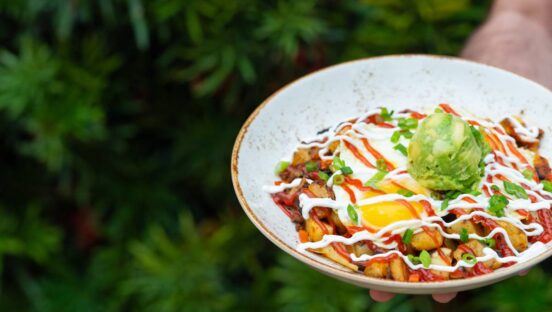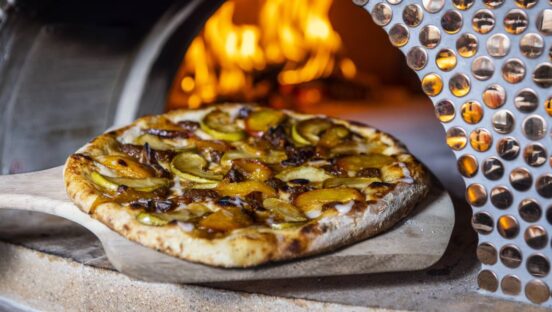







Life in the foodservice industry is more complex than ever, but resourceful restaurant operators are finding ways to cope with the multitude of operational challenges they now face. For most brands, maintaining business, and cutting costs amid the pivot to delivery and take-out only offerings are vital. Though the shift to off-premises dining is a big change for most of the industry, there are simple steps leaders can take that have a big impact on the bottom line without increasing operational complexity.
Consumers may not be eating in restaurant dining rooms, but serving up the dishes they crave is likely even more important than it was before. Now, restaurants can no longer rely on an appealing atmosphere or a great in-store experience to stand out from competitors.
One easy way to bring new life to a menu is by offering more breakfast dishes. Though breakfast has been a major industry buzzword since all-day offerings rose to prominence a few years ago, guest demand for the daypart hasn’t diminished.
As of March 2019, NPD’s blog reported that not only was breakfast showing consistent traffic growth over the previous few years, but breakfast was also the only foodservice daypart with year-over-year growth. Last year, Datassential also reported that the majority of consumers are expecting breakfast-like options on lunch and dinner menus. These expectations may grow, as diners often crave comforting dishes during times of stress, and breakfast offerings are particularly hearty.
Making your offerings stand out is also crucial, since they are what will drive people to a specific restaurant instead of the one listed below it online. But changing those offerings doesn’t have to be difficult.
“You don’t have to reinvent the wheel to start offering breakfast,” says Amy Thielking, marketing manager for Burke Corporation, a manufacturer of fully cooked meats. “If you don’t already serve breakfast, start with classic favorites. If you do breakfast but you don’t do it all day, consider offering two items at lunch or dinner.”
Adding more bold flavors to the menu is another great way to distinguish a restaurant from its competitors and attract more customers. “If you do offer breakfast, consider putting a twist on it that makes your offerings unique or try creating a premium offering instead of just eggs and bacon,” Thielking says. “Or start with a dish that diners are familiar with, like poutine, and add breakfast flavors to add a unique spin.”
Alternatively, restaurants can add more flavor to the menu by seeking global inspiration.
“Chilaquiles probably aren’t right for McDonald’s, but restaurants under 10 units might find some success with them,” Thielking says. “Mediterranean quiche might be another good pick. Restaurants could also try adding Asian flavors to breakfast dishes, or even Southern-influenced dishes, like breakfast fried rice with andouille sausage—something that makes them seem a bit different from their competitors.”
Pictured above: Mediterranean Quiche
Another simple way to drive guest demand and sales is to offer add-on flavors to dishes already on their menus. Add-ons not only create variety for consumers, but they also keep kitchen staff from becoming too overwhelmed as they might when a menu expands.
This is especially crucial as many restaurants are now operating with smaller staffs, says Mike Dougherty, vice president of sales and marketing at Burke. “If you already serve polenta, you can let customers add chorizo, sausage, or diced ham to it for an additional cost,” he adds.
Pictured above: Bacon and Avocado Toast
Catering to consumers’ diverse dietary needs is always a smart strategy, but it’s increasingly important now. As many consumers are staying home and choosing from restaurants on third-party delivery sites, they often ultimately order from places they know will accommodate their dietary needs. For example, offering more dishes that fit a Mediterranean or Paleo diet may be an effective strategy, Thielking says.
However, some restaurants are finding success by advertising specific nutritional qualities diners may look for rather than calling out the specific diets they follow. For example, designating foods “high in protein” on menus either with call outs or special sections would let a growing number of consumers looking for protein regardless of diet plan know that they will find the foods they need.
“Protein is an essential part of many different diet plans and making it easy to find dishes that fall into that category means you take some of the guesswork out of ordering delivery or takeout for diners,” Thielking says. “You’re saying we understand your needs.”
Pictured above: Beef and Mushroom Egg Bites
The rise of off-premises dining that was already taking over the foodservice industry meant restaurants already had to think about how their offerings would be consumed outside of the restaurant. But now that dining rooms are closing, it’s even more vital to consider not only the quality of food after it leaves the restaurant, but also how take-out consumers, such as delivery and truck drivers, mail carriers, and even healthcare staff on their way to-and-from work can eat foods on-the-go. Though these types of essential workers may be smaller in number than their counterparts staying home, providing menu offerings that suit their needs shows restaurants support them during a stressful time and make them—and their colleagues—more likely to come back. Consider offering items like sandwiches and wraps, which are convenient for carryout and easy for consumers to eat on the go. “Bowls remain very popular, they’re easy to make portable and fit the breakfast all day option that patrons love,” Dougherty says.
For consumers dining at home, it’s important for restaurants to try to offer menus that can survive the journey home. Meats, for example, may hold up better on the road than soups or ice cream, which could spill or melt. Providing tamper-proof packaging for third-party delivery orders could also help consumers feel more at ease about who has handled their food, and it may also be helpful to include reheating instructions if warm dishes are likely to cool before it reaches diners.
Pictured above: Sausage Mini Muffins
Staying profitable in the current economic climate isn’t just about driving sales; it’s also about reducing expenses. Many restaurants have been forced to cut back on staffing due to dining room closures or must operate with a skeleton crew if team members become sick. As a result, it’s important for restaurants to find ways to improve staff efficiency, particularly in the kitchen.
One way to do that is to use preseasoned and precooked ingredients, such as meat products that help brands save on labor. Not only do precooked meat products save on cooking time, but they also ensure consistency for restaurant chains and reduce the risk of food safety concerns, such as undercooking or contamination. They can also help restaurants reduce the time to train kitchen staff and drive additional operational efficiencies.
“Burke meat products are fully cooked, fully seasoned, and individually quick frozen, so restaurants only need to heat them,” Dougherty says. “This helps reduce labor costs, ensures safety, and means that back-of-house staff aren’t dealing with grease. Plus, you can take out exactly how much product you need for each dish and put the rest back in the freezer, so it simplifies prep, too.”
To add further cost and labor savings, restaurants can also work with precooked products that can work across the menu to reduce inventory levels and further streamline operations.
For example, Thielking says chorizo could be used in any daypart. “Chorizo is so versatile,” she says. “It can be used across the whole menu, so you’re bringing efficiency to your operations with just one ingredient.”
Pictured above: Belgian-Style Waffle with Chorizo
During times of crisis, it’s crucial for restaurants to find support across the industry, and suppliers are willing to help.
“We help restaurants identify trends and talk about how to use our products to drive results, and we have lots of different flavors, product sizes and tiers of products,” Dougherty says. “So we’re happy to help restaurants find the right solutions.”
To learn more about how restaurants can incorporate these strategies and more into their operations, visit meat.burkecorp.com/breakfast.












